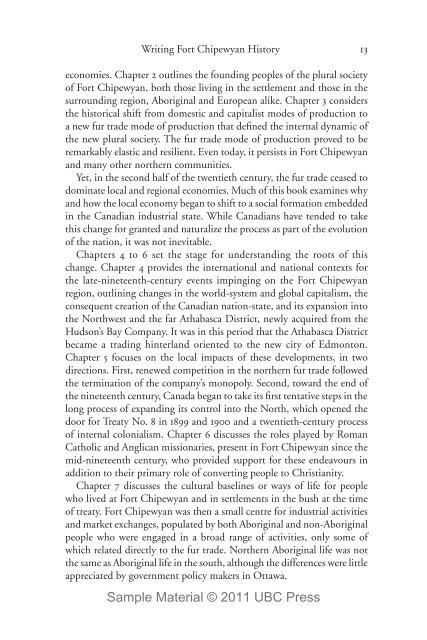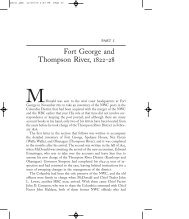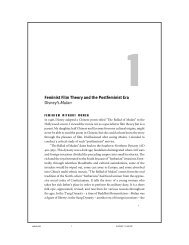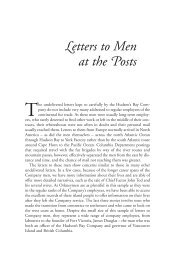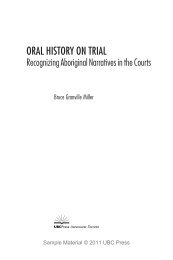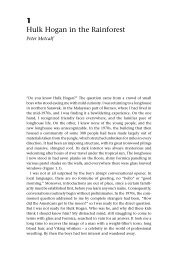Fort Chipewyan and the Shaping of Canadian History ... - UBC Press
Fort Chipewyan and the Shaping of Canadian History ... - UBC Press
Fort Chipewyan and the Shaping of Canadian History ... - UBC Press
You also want an ePaper? Increase the reach of your titles
YUMPU automatically turns print PDFs into web optimized ePapers that Google loves.
Writing <strong>Fort</strong> <strong>Chipewyan</strong> <strong>History</strong><br />
economies. Chapter 2 outlines <strong>the</strong> founding peoples <strong>of</strong> <strong>the</strong> plural society<br />
<strong>of</strong> <strong>Fort</strong> <strong>Chipewyan</strong>, both those living in <strong>the</strong> settlement <strong>and</strong> those in <strong>the</strong><br />
surrounding region, Aboriginal <strong>and</strong> European alike. Chapter 3 considers<br />
<strong>the</strong> historical shift from domestic <strong>and</strong> capitalist modes <strong>of</strong> production to<br />
a new fur trade mode <strong>of</strong> production that defined <strong>the</strong> internal dynamic <strong>of</strong><br />
<strong>the</strong> new plural society. The fur trade mode <strong>of</strong> production proved to be<br />
remarkably elastic <strong>and</strong> resilient. Even today, it persists in <strong>Fort</strong> <strong>Chipewyan</strong><br />
<strong>and</strong> many o<strong>the</strong>r nor<strong>the</strong>rn communities.<br />
Yet, in <strong>the</strong> second half <strong>of</strong> <strong>the</strong> twentieth century, <strong>the</strong> fur trade ceased to<br />
dominate local <strong>and</strong> regional economies. Much <strong>of</strong> this book examines why<br />
<strong>and</strong> how <strong>the</strong> local economy began to shift to a social formation embedded<br />
in <strong>the</strong> <strong>Canadian</strong> industrial state. While <strong>Canadian</strong>s have tended to take<br />
this change for granted <strong>and</strong> naturalize <strong>the</strong> process as part <strong>of</strong> <strong>the</strong> evolution<br />
<strong>of</strong> <strong>the</strong> nation, it was not inevitable.<br />
Chapters 4 to 6 set <strong>the</strong> stage for underst<strong>and</strong>ing <strong>the</strong> roots <strong>of</strong> this<br />
change. Chapter 4 provides <strong>the</strong> international <strong>and</strong> national contexts for<br />
<strong>the</strong> late-nineteenth-century events impinging on <strong>the</strong> <strong>Fort</strong> <strong>Chipewyan</strong><br />
region, outlining changes in <strong>the</strong> world-system <strong>and</strong> global capitalism, <strong>the</strong><br />
consequent creation <strong>of</strong> <strong>the</strong> <strong>Canadian</strong> nation-state, <strong>and</strong> its expansion into<br />
<strong>the</strong> Northwest <strong>and</strong> <strong>the</strong> far Athabasca District, newly acquired from <strong>the</strong><br />
Hudson’s Bay Company. It was in this period that <strong>the</strong> Athabasca District<br />
became a trading hinterl<strong>and</strong> oriented to <strong>the</strong> new city <strong>of</strong> Edmonton.<br />
Chapter 5 focuses on <strong>the</strong> local impacts <strong>of</strong> <strong>the</strong>se developments, in two<br />
directions. First, renewed competition in <strong>the</strong> nor<strong>the</strong>rn fur trade followed<br />
<strong>the</strong> termination <strong>of</strong> <strong>the</strong> company’s monopoly. Second, toward <strong>the</strong> end <strong>of</strong><br />
<strong>the</strong> nineteenth century, Canada began to take its first tentative steps in <strong>the</strong><br />
long process <strong>of</strong> exp<strong>and</strong>ing its control into <strong>the</strong> North, which opened <strong>the</strong><br />
door for Treaty No. 8 in 1899 <strong>and</strong> 1900 <strong>and</strong> a twentieth-century process<br />
<strong>of</strong> internal colonialism. Chapter 6 discusses <strong>the</strong> roles played by Roman<br />
Catholic <strong>and</strong> Anglican missionaries, present in <strong>Fort</strong> <strong>Chipewyan</strong> since <strong>the</strong><br />
mid-nineteenth century, who provided support for <strong>the</strong>se endeavours in<br />
addition to <strong>the</strong>ir primary role <strong>of</strong> converting people to Christianity.<br />
Chapter 7 discusses <strong>the</strong> cultural baselines or ways <strong>of</strong> life for people<br />
who lived at <strong>Fort</strong> <strong>Chipewyan</strong> <strong>and</strong> in settlements in <strong>the</strong> bush at <strong>the</strong> time<br />
<strong>of</strong> treaty. <strong>Fort</strong> <strong>Chipewyan</strong> was <strong>the</strong>n a small centre for industrial activities<br />
<strong>and</strong> market exchanges, populated by both Aboriginal <strong>and</strong> non-Aboriginal<br />
people who were engaged in a broad range <strong>of</strong> activities, only some <strong>of</strong><br />
which related directly to <strong>the</strong> fur trade. Nor<strong>the</strong>rn Aboriginal life was not<br />
<strong>the</strong> same as Aboriginal life in <strong>the</strong> south, although <strong>the</strong> differences were little<br />
appreciated by government policy makers in Ottawa.<br />
Sample Material © 2011 <strong>UBC</strong> <strong>Press</strong><br />
13


